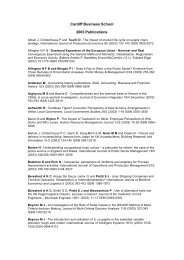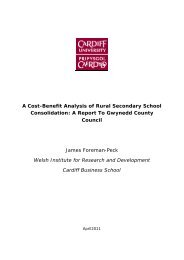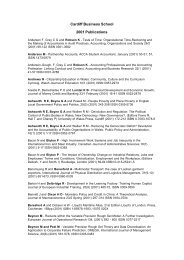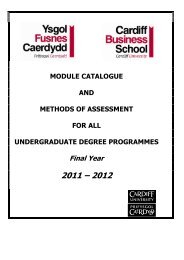Revisiting the Great Moderation using the Method of Indirect Inference
Revisiting the Great Moderation using the Method of Indirect Inference
Revisiting the Great Moderation using the Method of Indirect Inference
You also want an ePaper? Increase the reach of your titles
YUMPU automatically turns print PDFs into web optimized ePapers that Google loves.
given that <strong>the</strong> Wald statistic is asymptotically pivotal. They also showed it had quite<br />
good accuracy in small sample Montecarlo experiments 11 .<br />
This testing procedure is applied to a set <strong>of</strong> (structural) parameters put forward as<br />
<strong>the</strong> true ones (H 0 , <strong>the</strong> null hypo<strong>the</strong>sis); <strong>the</strong>y can be derived from calibration, estimation,<br />
or both. However derived, <strong>the</strong> test <strong>the</strong>n asks: could <strong>the</strong>se coecients within this model<br />
structure be <strong>the</strong> true (numerical) model generating <strong>the</strong> data? Of course only one true<br />
model with one set <strong>of</strong> coecients is possible. Never<strong>the</strong>less we may have chosen coecients<br />
that are not exactly right numerically, so that <strong>the</strong> same model with o<strong>the</strong>r coecient values<br />
could be correct. Only when we have examined <strong>the</strong> model with all coecient values that<br />
are feasible within <strong>the</strong> model <strong>the</strong>ory will we have properly tested it.<br />
For this reason<br />
we later extend our procedure by a fur<strong>the</strong>r search algorithm, in which we seek o<strong>the</strong>r<br />
coecient sets that could do better in <strong>the</strong> test.<br />
Thus we calculated <strong>the</strong> minimum-value full Wald statistic for each period <strong>using</strong> a<br />
powerful algorithm based on Simulated Annealing (SA) in which search takes place over<br />
a wide range around <strong>the</strong> initial values, with optimising search accompanied by random<br />
jumps around <strong>the</strong> space 12 . In eect this is <strong>Indirect</strong> <strong>Inference</strong> estimation <strong>of</strong> <strong>the</strong> model;<br />
however here this estimation is being done to nd whe<strong>the</strong>r <strong>the</strong> model can be rejected<br />
in itself and not for <strong>the</strong> sake <strong>of</strong> nding <strong>the</strong> most satisfactory estimates <strong>of</strong> <strong>the</strong> model<br />
parameters. Never<strong>the</strong>less <strong>of</strong> course <strong>the</strong> method does this latter task as a byproduct so<br />
that we can use <strong>the</strong> resulting unrejected model as representing <strong>the</strong> best available estimated<br />
11 Specically, <strong>the</strong>y found that <strong>the</strong> bias due to bootstrapping was just over 2% at <strong>the</strong> 95% condence<br />
level and 0.6% at <strong>the</strong> 99% level. They suggested possible fur<strong>the</strong>r renements in <strong>the</strong> bootstrapping<br />
procedure which could increase <strong>the</strong> accuracy fur<strong>the</strong>r; however, we do not feel it necessary to pursue <strong>the</strong>se<br />
here.<br />
12 We use a Simulated Annealing algorithm due to Ingber (1996). This mimics <strong>the</strong> behaviour <strong>of</strong> <strong>the</strong><br />
steel cooling process in which steel is cooled, with a degree <strong>of</strong> reheating at randomly chosen moments<br />
in <strong>the</strong> cooling process|this ensuring that <strong>the</strong> defects are minimised globally. Similarly <strong>the</strong> algorithm<br />
searches in <strong>the</strong> chosen range and as points that improve <strong>the</strong> objective are found it also accepts points<br />
that do not improve <strong>the</strong> objective. This helps to stop <strong>the</strong> algorithm being caught in local minima. We<br />
nd this algorithm improves substantially here on a standard optimisation algorithm. Our method used<br />
our standard testing method: we take a set <strong>of</strong> model parameters (excluding error processes), extract <strong>the</strong><br />
resulting residuals from <strong>the</strong> data <strong>using</strong> <strong>the</strong> LIML method, nd <strong>the</strong>ir implied autoregressive coecients<br />
(AR(1) here) and <strong>the</strong>n bootstrap <strong>the</strong> implied innovations with this full set <strong>of</strong> parameters to nd <strong>the</strong><br />
implied Wald value. This is <strong>the</strong>n minimised by <strong>the</strong> SA algorithm.<br />
17








